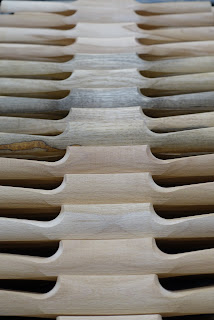I should start off by making it clear, if you don't read my blog, that I am friends with Pete and this could be easily categorized as a biased review. I realize this but I am a chairmaker so here is my opinion. In fact it is probably just as much about my thoughts on sharpening in general.
If you haven't already seen the
videos Peter has posted on how this works in use then I recommend checking them out to get the concept. UPDATE: Pete put up a post talking about why he designed this tool. Check it out
here.
So is the Drawsharp just another sharpening jig? At first that is how I was looking at it. I guess it is. But I was thinking about how a turner uses jigs to rest there tools on supports to grind the edge or hold the tool in some other way while sharpening. I use jigs in these instances because they make my sharpening retain or achieve the shape I want as well as get there quickly without worrying about achieving a cutting geometry that is crucial to good turning. On the other hand, unless I see a real advantage, I am just too focused on what I am making to fuss with a jig, whatever it is, unless I see that it actually makes my work faster, better, or lessens the interruption of my craft which I think is hugely important. I sharpen all my plane irons by hand for this reason though I can see someone arguing for using a jig to do this faster but they just seem to irritate me.
What do I think of the Drawsharp? Is it a faster, slower or just a more accurate way of sharpening? Before I answer that I should say that I think this tool has two distinct tasks it can accomplish. First it would help you rehab a drawknife that is in the typical shape when found at a flea market or the like. Essentially the edge is very beat up. If you don't want to attempt doing all the clean up on a grinder then this is a far less intimidating way to get it to functioning and I think it may in some ways be just as quick if not possibly quicker. This of course really has more to do with the current condition of the drawknife.
My drawknives are in fine shape so I can't really comment on this process or the speed other than messing around with a few beat up drawknives at Peter's booth at Woodworking In America, the show these debuted at. It was quick, I must admit. It was simple for the first time user which would be the main reason I see some one like that using it. I came to realize it is much cheaper to rehab 3 flee market drawknives even considering the purchase of the Drawsharp than it is to buy a decent new drawknife which then still leaves you with only one drawknife and the standard method of sharpening it. A few different drawknives in chair making is useful if not necessary.
That takes me to the second task this accomplishes and the one I think makes it really most useful to me. It maintains the edge of the knife consistently and without fuss. For instance it takes me about 8 minutes to set up and resharpen my knife and get back to work with my traditional method which is a jig that holds my sharpening stone in an elevated position above my bench. However, the Drawsharp allows me to never even leave my shave horse to get my edge back up to full throttle. It seems to take me about 45 seconds once it is in my hand to be satisfied with the edge especially since maintaining it is so easy I don't even think to not just do it once I get the notion it is approaching dull.
In the end I would say that two types of people would be suited to the Drawsharp the best. The first is if you want to rehab a knife or knives and don't feel comfortable with the grinder for this task. I don't blame you since it is tricky.
Second is the person that does a lot of drawknife work and the down time this saves out weighs the cost of the tool or you simply do this for a hobby and your free time in the shop is of more value than the cost of the tool.
So if you don't mind rehabbing your drawknife with a grinder or you have enough time in your craft to sharpen the old way or enjoy this method of sharpening then you can pass on this tool.
Hope that helped anyone who was trying to decide if this tool was right for them.
Final disclaimer- I do not profit from the sale of this tool.












